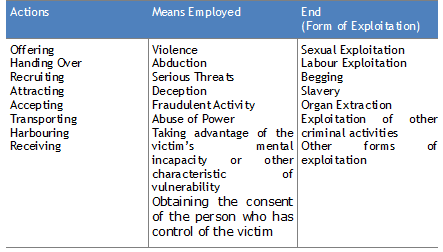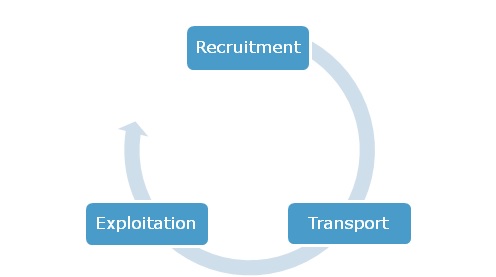What is Trafficking in Human Beings
Human trafficking is the internal or cross-border transportation of people for abuse and exploitation. It is a is crime defined in international law as: “The recruitment, transportation, transfer, harboring or receipt of persons, by means of the threat or use of force or other forms of coercion, of abduction, of fraud of deception, of abuse of authority or of a position of vulnerability or of the giving or receiving of payments or benefits to achieve the consent of a person having control over another person for the purpose of exploitation.”
This definition comes from laws by the United Nations and by the Council of Europe. In the UK there is no single piece of legislation on human trafficking, however it is bound by the EU Convention which legally came into force in the UK in 2009. The definition of trafficking in the UK is the same as above in international law.
The crime of human trafficking has a complex definition. We can think of it as involving three parts:
o Actions such as recruitment, transporting and receiving victims.
o Using means such as threats, coercion, deception, fraud, abusing vulnerability
o For the purpose of exploitation, such as forced labour or slavery, sexual exploitation, domestic servitude, criminal activities, forced marriage among others.
The table below illustrates this:

To be considered as such, the crime of trafficking in human beings requires a combination of one or more factors of each column, as in the examples highlighted by the arrows.
According to its legal definition, we can say that human trafficking happens with the following cycle:

Recruitment
The recruitment and deception of victims of trafficking happens in different ways, depending on the type of victim targeted (adults or children, male or female, transgender) and the type of exploitation planned (labour, sexual or other forms of exploitation). Recruitment can be done through fake job ads, promising opportunities for study or training, promises of love, relationships and support. Traffickers promise to arrange victims migrating to another place (to a different country or place within the same country), or they abduct the victim.
They deceive people by promising a new future (work, study, relationships or other) that never materialises, in order to lure people and lead them into an exploitative situation.
Recruitment can be done either by people unrelated to the victim or by known contacts and even family members.
These people may act alone or as part of a criminal organisation. The contact with the victim can be set personally (especially in the case of acquaintances and family) or through a medium of mass communication, such as newspapers and the internet, which is increasingly being used.
There are also ‘grey’ areas, where legal or semi-legal brokers, companies and/or its agents along supply chains, play a mediating role in the recruitment of potential victims, but are not necessarily acting with criminal intent. For example, employment agencies that broker work for people but which then leads to exploitation or companies unwittingly using exploitative brokers. However overall, much more research is needed on traffickers and their methods: who they are, how they operate, and the techniques and strategies they employ.
Transport
The transport and movement of the victims is the second part of the trafficking process. This can be either to a place in the same country where the victim was recruited (within country borders) or a different country (involving crossing of borders). The transport tends not to follow a direct path from the source to the destination – it is common for traffickers to use complex routes and pass through many different countries or regions.
Victims can be transported by the recruiters or future exploiters, or even move alone, following the directions of traffickers.
The ways victims are transported varies. Common forms of public transport (e.g. bus, train, plane) are used, private vehicles (e.g. cars) or other types of transportation for moving several victims at once (e.g. vans, lorries, boats). Transport conditions are often poor: without sufficient oxygen, with excess passengers in inappropriate places (such as within the cargo of lorries) and other ways that damage the health and the lives of people being transported.
There is often confusion between human trafficking and smuggling. While in some cases the transport of victims of trafficking and the illegal migrants smuggled into the UK are similar, this is not always the case, and there crucial differences between human trafficking and people smuggling (see myths and facts below).
EXPLOITATION
Exploitation completes the cycle of trafficking. As mentioned earlier, forms of exploitation in the trafficking of human beings are varied. This can include trafficking for forced labour and slavery-like practices, sexual abuse and exploitation, domestic servitude, criminal exploitation (forced begging, pickpocketing, work in cannabis plantations, benefit fraud), illicit child adoption, forced marriage, organ removal among others (see section on other forms of trafficking). The common feature is that the victims are forced to perform an activity through threats or other forms of coercion and abuse of power and control, and they have no or restricted freedom of movement. The intention to exploit someone after they arrive at a location is central to understanding what human trafficking is, and differentiates it from people smuggling (see myths and facts below).
For all these reasons, myths or misconceptions about human trafficking are common. This can lead to confusion, difficulties in accurately understanding this crime and also difficulties in identifying possible trafficking situations and who the victims are. Demystifying and clarifying any misunderstandings about the concept of human trafficking is essential to promote awareness of trafficking and its prevention.
1) Only women are victims of human trafficking and it only involves sexual exploitation.
MYTH. One of the main myths linked to trafficking in human beings is the belief that this only affects women who are forced against their will into sexual acts. Actually victims can be both female and male and of various ages – children account for a large percentage of victims of trafficking. Men, women, transgender people, and children of both sexes are subjected to different forms of exploitation, and in many cases the same victim is subjected to more than one type simultaneously or one form of exploitation leads to another. Different forms of exploitation can include labour exploitation, domestic servitude, criminal exploitation (such as forced labour in cannabis factories), forced marriage, organ harvesting, illicit adoptions among others (see section on different types of trafficking).
2) Human trafficking only happens to immigrants from poor countries with low levels of education.
MYTH. Many victims of human trafficking also come from developed countries and with higher education, for example, victims trafficked from European countries or within country borders such as within the UK.
3) Human trafficking is the same as people smuggling of illegal migrants.
MYTH. There is often confusion between human trafficking and people smuggling. This is because in some cases the transport used is similar (e.g. people hidden in vehicles, in poor conditions, with limited food or oxygen). But this is not always the case, and there are crucial differences between people smuggling and human trafficking:
– Not all victims of trafficking cross borders illegally, whereas smuggling always involves illegal entry.
– Trafficking takes can take place within national borders unlike smuggling.
– Trafficking uses coercion, deception, force or abuse of power whereas smuggling is a voluntary act on the part of migrants.
– Trafficking also involves exploitation of people when they reach their destination.
4) The traffickers may operate through travel and employment agencies, promising work abroad and documentation.
FACT. Many recruiters use tools like fake adverts, employment and travel agencies, to attract and deceive people by false promises, who then may become victims of exploitation. This includes brokers which are intermediary agencies involved in negotiating contracts for a fee are also used, such as employment brokers.
These brokers are not always criminal organisations: there are also ‘grey areas’ where brokers are legal or semi-legal companies or individuals not acting with criminal intent but who lack awareness of employment rights or human trafficking. Or they are unknowingly linked to exploitative and criminal groups in their supply chains.
5) Recruitment of victims in human trafficking always involves physical violence or abduction.
MYTH. There is clear evidence that trafficking in human beings does not necessarily involve the victim being abducted, forcibly taken and subjected to violence. Situations are also common where the person is deceived by believing a false proposition or promise and then the victim moves using his own means to the place where they end up being exploited. Victims are often forced into exploitation through emotional abuse, manipulation, threats, power and control, playing on the person’s vulnerabilities and fears such as keeping them in debt, their illegal immigration status, or social isolation and dependence. Some victims can also be framed for the crime of trafficking as a form of control.
6) During exploitation victims of trafficking do not have the freedom to leave.
FACT. To be a crime of trafficking in human beings, the victim has been held without a viable alternative to leave the exploitative situation. They are forced through physical or moral coercion, to do something against their will (for example they forced to work or into prostitution). Victims may also be involved in crime (such as drug production) as a way to control and keep them dependent on those exploiting them. However, not having the freedom to leave does not mean that all victims are physically locked up. Many victims are held in their exploitative situation through emotional abuse and control which prevents them from leaving.
7) Victims of trafficking in human beings are just illegal immigrants trying to scrounge work or benefits.
MYTH. It is common misconception to see victims of trafficking as immigrants who deliberately cross the border illegally in order to get work or benefits. This does not take into account that victims of trafficking are deceived, tricked, coerced or forced into travelling and when they reach their destination they experience exploitation. This situation is manifestly different from people who choose to migrate freely, either legally or illegally. It is important to note that any initial consent of a trafficked person to travel – legally or illegally – becomes irrelevant if any of the ‘means’ of trafficking are used e.g. if they are deceived, tricked or coerced the fact that they initially consented is irrelevant in international law (see section on definitions of human trafficking). Similarly, not all victims of trafficking travel illegally: in some cases traffickers get all the legal documentation for victims so they enter a country without suspicion and to ensure that the victim arrives. In this way victims are tricked into believing they are being helped legally in their migration and only after arriving at their destination they realise they have been deceived and will be exploited.
8) People will easily know and say that they are victims of trafficking.
MYTH. It is common for people who have been trafficked to not know what trafficking is or to recognise that they are ‘victims’ of trafficking. Instead they will see themselves as being in a bad situation (e.g. seeing themselves as a worker that has been exploited) or they may not be aware that they are being exploited (e.g. not knowing about UK labour rights, or due to complex emotional abuse and control they may not condemn their abuser).
9) All victims of Human Trafficking are foreigners coming from other countries.
MYTH. Victims of human trafficking do not have to cross country borders. There are many cases of UK citizens being trafficked internally within the UK to another location and exploited. Groups at risk can include those unemployed, homeless, with alcohol & drug dependency, mental health problems or looked after children.
10) Human Trafficking is the one of the most profitable crimes in Europe.
FACT. It is estimated that the trade in human beings is one of the most lucrative crimes, second only to drug trafficking and weapons.
11) Trafficking in human beings generates profit through the exploitation of the victims.
FACT. Victims of human trafficking can experience different forms of exploitation which makes profits for exploiters. Either because those exploiting keep all the money that the victim receives (such as prostitution or begging), or because the victim does not receive any wages for the work they do (or being forced to work in agriculture or construction without receiving any salary).
The factors that cause the crime of trafficking in human beings are complex and multilayered. They are often linked to people’s socio-economic circumstances such as poverty, poor employment opportunities, psychological and emotional vulnerabilities, family difficulties, and discrimination. These difficulties can be ‘push factors’ in leading people to look for opportunities elsewhere but they can be vulnerable to exploitation. Traffickers exert control over their victims by exploiting these vulnerabilities, such as isolation and lack of language skills in a new country, illegal immigration status, poverty, age, gender or ill-health. They exploit the victims, generally for money or financial gain. For example, the victim is forced to perform a job without pay (as in labour exploitation) or for any money or benefits to given to the exploiters (sexual exploitation or benefit fraud).
At the other end, increasing demands for a particular skill, service or product can be one of the ‘pull factors’ causing trafficking. For example, labour and skills shortages that increase the demand for migrant labour, in unskilled or undesirable jobs, such as demand for carers, fruit pickers, or domestic workers. There can be high financial gains for traffickers and exploiters e.g. hiring trafficked or undocumented workers as cheap labour, or from women trafficked into prostitution.
For example, a town with several large fruit farms who compete to provide the lowest price can create demand by being willing to employ people without pay or with very low wages to increase profits. But in another location if there is high unemployment and low standard of living, people can become vulnerable to becoming a supply of trafficking victims.
Overall, human trafficking is caused by a complex interaction of risk factors among potential victims. In the above example, the risk factors are unemployment and low living standards. Poverty has been identified as the most common risk factor for human trafficking. However, there are a range of other factors can further trigger or increase vulnerability to human trafficking. Examples of risks can include:
• Separation and isolation from family (e.g. children separated because war or natural disaster, looked after children)
• Domestic violence (both children and adults who have no money to leave the violent situation and who may be at risk of repeated victimisation due to early and or severe abuse).
• Undocumented migrants (in the country illegally and without status)
• Homelessness
• Sex workers (prostitutes, escorts, workers in strip clubs & pornography)
• People or groups subject to racial or ethnic discrimination
• Gender discrimination (e.g. women struggling to get work in origin countries)
• Social exclusion
• Unaccompanied children in transit between different countries
• Child labor
• Children whose birth was not recorded by any official body
• Alcohol or drug dependency that is pre-existing or induced by the traffickers
• Mental Health problems
• Offenders or people involved in crime
• Unemployment
• Lack of inspection in workplaces
• Lack of awareness & information on labour rights and human trafficking




